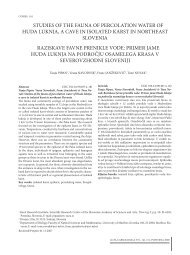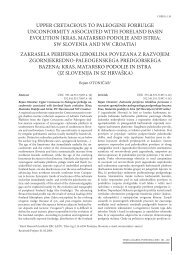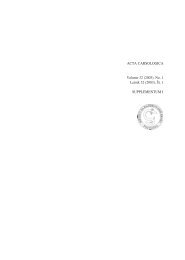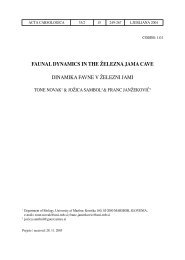Download pdf - Acta Carsologica - ZRC SAZU
Download pdf - Acta Carsologica - ZRC SAZU
Download pdf - Acta Carsologica - ZRC SAZU
You also want an ePaper? Increase the reach of your titles
YUMPU automatically turns print PDFs into web optimized ePapers that Google loves.
Stanka ŠEBELA<br />
zone, which was active before the final formation of the<br />
passage.<br />
Čar et al. (2002) described that active tectonics<br />
along the northern part of Cerknica Polje is very strong.<br />
They compare the position of the systems of Postojna and<br />
Planina Caves, with Križna Cave, because between those<br />
there is an offset of 12 km, which is due to dextral movement<br />
along the Idrija Fault.<br />
During the exploration of the 1,2 km long and 173<br />
m deep Hirschgrubenhöhle, abundant scratched, sheared<br />
and broken speleothems were found. Because Quaternary<br />
mass movement and ice-movement in the cave, which<br />
are known to cause deformations on speleothems, can be<br />
excluded, these deformations are presumably sismothems,<br />
i.e. speleothems that were broken or deformed by<br />
fault slip associated with seismic events. The cave is located<br />
8 km south from the master fault of the left-lateral<br />
Salzachtal-Ennstal-Mariazell-Puchberg-Line (SEMP).<br />
First results suggest that a seismic event with at least 20<br />
cm offset (sinistral strike-slip) took place between 11-86<br />
Ka (Plan et al. 2005).<br />
Unstuck parts of the vault, broken stalactites, and<br />
horizontally sheared columns show that the Wintimdouine<br />
Cave in Marocco was and is still modeled during the<br />
time of vertical and horizontal shifts that correspond to<br />
the contemporary rising up of High Atlas and its thrusting<br />
to the south. This dynamic is sprinkled by brief seismo-tectonic<br />
events, such as are recorded in speleothems<br />
(Angelova et al. 2005).<br />
In the Rochefort Cave (Belgium) the recent tectonic<br />
features are bedding planes reactivated as normal faults.<br />
The faults are still active because fresh scaling and fallen<br />
blocks are observable (Vandycke & Quinif 2001).<br />
In the shaft of Avent Abel and Calernaum (France),<br />
the recent movement of a thrust fault has cause the breakage<br />
of many speleothems (Gilli 1992 and 1999 e).<br />
Gilli & Delange (2001) examined the active movements<br />
of thrust faults along which karst caves are developed<br />
in France. They found proof of displaced faults and<br />
broken flowstone.<br />
Evidences of seismic events<br />
in the caves<br />
Fig. 3: The fault zone in Vzhodni Rov of Predjama (photo J. Hajna).<br />
Among the older scientists and relation between flowstone<br />
and earthquakes, there is a work by Becker (1929)<br />
about the Bing Cave in Germany and Han-sur-Lesse<br />
(Belgium).<br />
Postpischl et al. (1991) recognized that karst caves<br />
have great potential for the study of tectonic, especially<br />
paleoseismic, events. They recognized that deviations<br />
from vertical growth for stalagmites could be caused by<br />
local factors (such as movements of supporting blocks),<br />
or they could be due to tectonic events and earthquakes.<br />
The evidence for earthquakes in karst caves, can be seen<br />
in: deviation of growth axes (from the vertical), differences<br />
in flowstone growth, and colour differences in speleothem<br />
bands, possibly resulting from changes in the<br />
physio-chemistry of percolation water input.<br />
Postpischl et al. (1991) examined the growth of<br />
flowstone in two different caves (Buco dei Buio and Spipola<br />
near Bologna, Italy), particularly with respect to a<br />
strong earthquake that occurred in the region on January<br />
3, 1117. The epicenter was 15 km far from these caves.<br />
They found that the observed anomalies in the stalagmite<br />
growths are always related to earthquakes or at least to<br />
tectonic events.<br />
In southern Italy, the same researchers (Postpischl<br />
et al. 1991) examined Grotta Grande del Cervo. They<br />
analyzed 25 stalagmites using 14-C and U-Th disequilibrium<br />
methods. They were able to connect some morphological<br />
deviations in the speleothems with times of<br />
known seismic events. The earthquake of December 1456<br />
was particularly obvious. In the last 350 Ka they believe<br />
that there were 4 strong earthquakes, with the 1456 one<br />
being the most recent. That one, as indicated by archaeo-<br />
54<br />
ACTA CARSOLOGICA 37/1 – 2008







